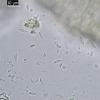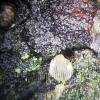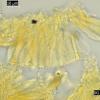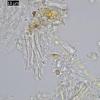
18-12-2025 21:17
Pol DebaenstThe identification took me to Byssonectria deformi

15-12-2025 07:09
 Danny Newman
Danny Newman
indet. Rutstroemiaceae sp. on unk. fallen leavesMc

19-12-2025 10:10
Patrice TANCHAUDBonjour, récolte réalisée en milieu dunaire, a

18-12-2025 17:23
 Bruno Coué
Bruno Coué
Bonjour,je serais heureux d'avoir votre avis sur c

18-12-2025 18:07
Margot en Geert VullingsThese plumes were found on rotten wood.They strong

17-12-2025 18:35
 Michel Hairaud
Michel Hairaud
Bonjour à tous/Hi to everyone I am passing along

15-12-2025 15:48
 Danny Newman
Danny Newman
Melanospora cf. lagenaria on old, rotting, fallen

15-12-2025 15:54
 Johan Boonefaes
Johan Boonefaes
Unknown anamorph found on the ground in coastal sa

15-12-2025 21:11
 Hardware Tony
Hardware Tony
Small clavate hairs, negative croziers and IKI bb
I found this small yellow ascomycete on a rotten willow branch on 05.02.2022.
Unfortunately there was only one. That's why there are so few microfeatures.
The branch is damp, maybe there is still growth.
Size of the FK approx. 1- 1.2 mm.
Microfeatures see appendix.
Spores [95% - 8 - QPr - v - H2O(nat) ] = 6,5 - 8,4 - 10,4 x 2 - 2,7 - 3,3 µm; Q = 2,5 - 3,9.
OCI 1
Spore shape you can judge yourself, i dont know the correkt name for the form.
I think I saw spores with cilia in the preparation.
Porus reaction negative even with pre-treatment KOH.
Ascus base hook+
Could it be a Mollisia?
Kind regards and thank you very mutch
Dirk


Thank you for your quick answers.
The genus is completely new to me, but I have compared the characteristics as well as possible with your monograph. The waxy, hygrophane appearance of the fruit body also fits very well there, which is not so good to see in the photo.
To determine the species now exactly as Hyalorbilia_fusispora, I lack the experience.
But thank you again.
Kind regards
Dirk

yes the scale is 1mm.
The spore illustrations in your "folder fusispora" exactly match the ones I have seen, which unfortunately I cannot check anymore is,is the reaction of the spores to KOH.
But it's good to know this if similar findings turn up again.
And so I think and hope that the find can be filed with H._fusispora cf.
Thank you for your support!

you don`t need to check if the spore bodies are KOH soluble. They are (at all orbilioid species). They are dissolved when the spore dies.
Yours, Lothar

thank you very much for your interesting answers.
As an absolute layman in this matter, one must understand this first. But on this way one can only learn.
Maybe I can find some more orbilioid species to try the whole thing out again.
Herzliche Grüße
Dirk

übrigens freue ich mich, hier von Dir zu lesen.
Aller Anfang ist schwer - und Orbilia sicher bersonders.
Herzliche Grüße von Lothar
danke und gerne bin ich hier, vor allem bei solch netten Leuten.
Ja, ab und zu versuche ich auch Ascomyceten zu bestimmen. Meist scheitere ich ober brauche Hilfe von
Freunden unnd Gleichgesinnnten.
Aber der Anfang ist gemacht.
Liebe Grüße auch daheim
Dirk




